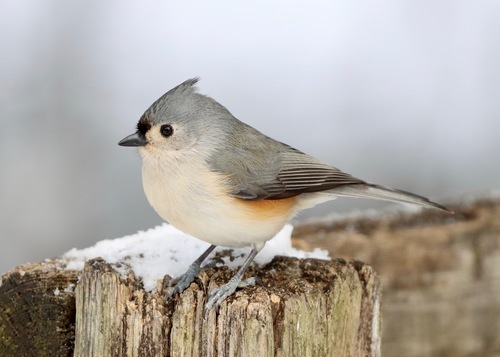
Tufted Titmouse
The Tufted Titmouse (Baeolophus bicolor) is a small, active songbird common throughout the eastern and central United States. Known for its distinctive pointed crest, large black eyes, and soft, gray plumage, this species is a familiar sight at backyard feeders and in deciduous woodlands. Ecologically, the Tufted Titmouse plays a vital role in controlling insect populations, particularly during the breeding season when they feed their young a diet almost exclusively of caterpillars. They are also important seed dispersers. While not culturally significant in the same way as some larger or more colorful birds, their cheerful presence and curious nature have made them a beloved species among birdwatchers.
14-16 cm
Length
20-26 cm
Wingspan
Least Concern
Conservation Status
Distribution
The Tufted Titmouse is primarily found in the eastern and central United States, ranging from southern Ontario and Quebec in Canada, south to Florida, and west to Texas and parts of northeastern Mexico. They are non-migratory, remaining in their established territories year-round.
Lifespan
Average lifespan in the wild is about 2 years, but some individuals have been recorded living over 10 years.
Tufted Titmouse's Habitat
Habitat Types
Deciduous forests, Mixed woodlands, Suburban parks, Residential areas with mature trees
Climate Zones
Temperate, Subtropical
Adaptations
Tufted Titmice are well-adapted to human-altered landscapes, often thriving in suburban and even urban environments as long as sufficient tree cover and nesting cavities are available. Their strong legs and feet allow them to cling to branches and bark while foraging.
Variations
There are subtle regional variations in plumage and size. Birds in the southern part of the range tend to be slightly smaller and may have a buff-colored wash on their flanks. The 'Black-crested Titmouse' of Texas and Mexico was once considered a separate species, but it's now considered a subspecies ( *Baeolophus bicolor atricristatus*).
Appearance
Breeding Plumage
Plumage is similar year-round.
Seasonal Feather Changes
No significant seasonal variations.
Sex Based Plumage Differences
Males and females have nearly identical plumage.
Notable Features
Prominent gray crest, Large black eyes, White underparts with rusty flanks, Gray upperparts
Diet and Feeding
Primary Foods
Insects, Spiders, Seeds, Berries, Nuts
Foraging Behavior
Tufted Titmice are active foragers, gleaning insects and spiders from leaves, branches, and tree bark. They often hang upside down to examine the undersides of leaves. They also readily visit bird feeders, taking sunflower seeds, peanuts, and suet.
Specializations
Their strong bills are well-suited for cracking open seeds and nuts. They often cache food, storing seeds and nuts in crevices in bark or under leaves for later retrieval.
Seasonal Diet Variations
Their diet shifts seasonally. During the breeding season, they primarily feed on insects, especially caterpillars, which are crucial for feeding their young. In winter, they rely more on seeds, nuts, and berries.
Behavior
Social Structure
Tufted Titmice are often found in pairs or small family groups, especially during the breeding season. In winter, they may join mixed-species flocks with other small birds like chickadees and nuthatches.
Communication
A variety of calls and songs, The most common call is a whistled 'peter-peter-peter', Scolding calls when threatened
Migration
Non-migratory; they remain in their territories year-round.
Territorial or Group Behaviors
They are territorial during the breeding season, defending their nesting area from other titmice. They are less territorial in winter, often foraging in small flocks.
Conservation
Threats
Habitat loss due to deforestation, Competition with invasive species (e.g., House Sparrows) for nesting cavities, Pesticide use that reduces insect prey
Protection Programs
General habitat conservation efforts benefit this species, Providing nest boxes can help increase breeding success in areas with limited natural cavities
Local National Laws
Protected under the Migratory Bird Treaty Act in the United States.
Population Trend
Stable
Population Estimates
The global population is estimated to be around 13 million individuals.
Interesting Facts
They often line their nests with hair.
Tufted Titmice have been observed plucking hair from live animals, including dogs, squirrels, and even humans!
They are known for their food caching behavior.
They store seeds and nuts in crevices, retrieving them later when food is scarce.
They can recognize individual human faces.
Studies have shown that they can distinguish between different people and remember those who have previously threatened them.
Faqs about Tufted Titmouse
What do Tufted Titmice eat?
They eat a variety of insects, spiders, seeds, berries, and nuts. They readily visit bird feeders.
Where do Tufted Titmice nest?
They nest in tree cavities, old woodpecker holes, or nest boxes.
Do Tufted Titmice migrate?
No, they are non-migratory and stay in their territories year-round.
How can I attract Tufted Titmice to my yard?
Provide a bird feeder with sunflower seeds, peanuts, or suet. You can also install a nest box.
Copyright @ Nature Style Limited. All Rights Reserved.
 English
English